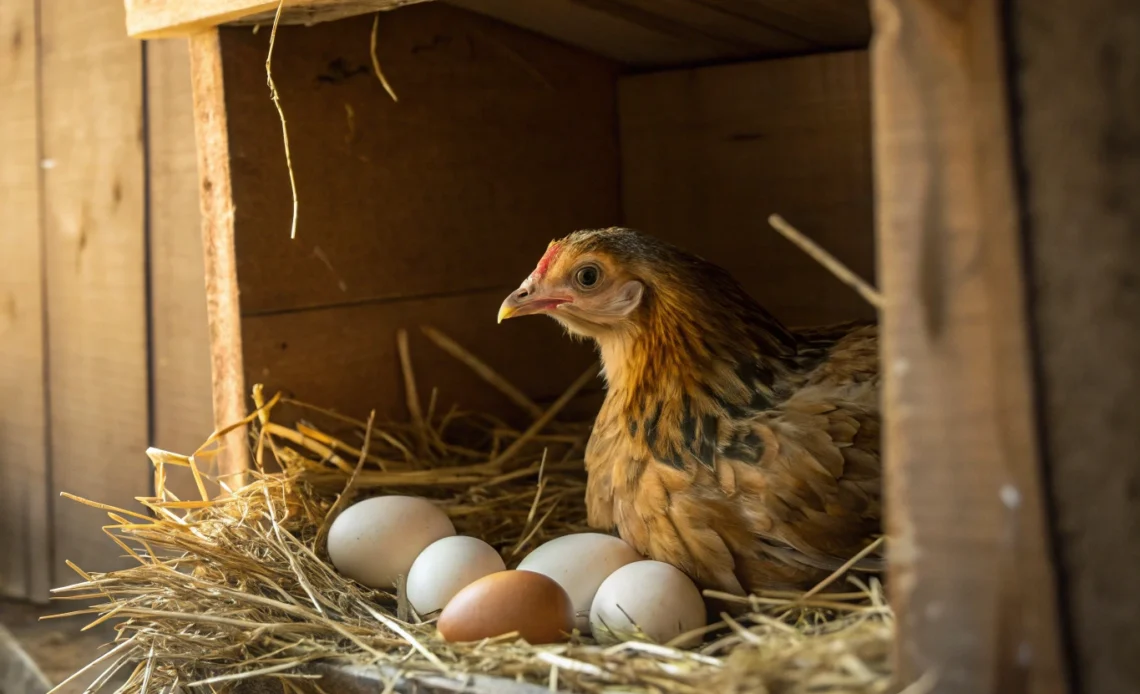
ANNONCE
Table of Contents
ANNONCE
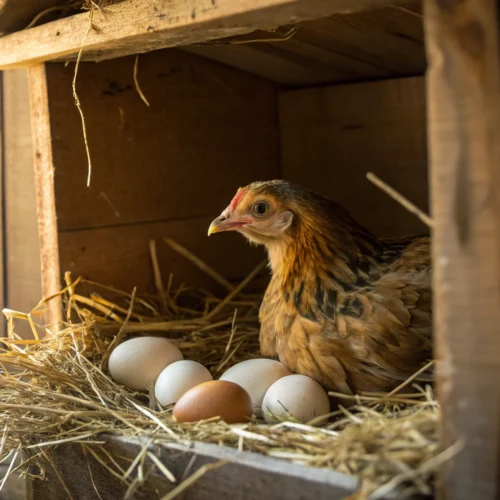
Frizzle Chickens Care Guide
Equipment
- Poultry Coop
- Feeding Trays
Ingredients
Frizzle Chicken Care Essentials
- Healthy Diet
- Dry Bedding
- Insulated Coop
Instructions
- Provide a well-insulated, draft-free poultry coop to ensure Frizzle chickens stay warm during colder months.
- Maintain a balanced diet, rich in protein and supplemented with greens, grains, and occasional treats like scrambled eggs or yogurt.
- Perform regular health checks to ensure your Frizzles are free from mites and lice. Make sure they get plenty of dust baths to stay clean.
Notes
Introduction to Frizzle Chickens
I still remember the first time my abuela took me to a local farm fair in our little Texas town. Amidst the clucking and flapping of every imaginable breed of chicken, one caught my eye like no other. Its feathers curled outward like it had just stepped out of a wind tunnel. “Mija,” she chuckled, “that there is a Frizzle. They’re fancy, but don’t be fooled—they’re sweethearts.”
Ever since that moment, I have been fascinated by Frizzle chickens. These birds are not just another backyard breed; they are a delightful mix of flamboyance and friendliness. What makes them so special? Their feathers grow in reverse, curling out instead of lying flat, giving them a unique, almost whimsical appearance that sets them apart from other poultry.
But their charm does not end with aesthetics. Frizzles are known for their docile nature, making them ideal for families, hobby farmers, and poultry enthusiasts alike. Despite their somewhat fragile looks, they are hardy and versatile birds that adapt well to a range of environments.
ANNONCE
If you have ever considered adding an ornamental but productive breed to your flock, or if you’re simply intrigued by chickens that look like feathered pom-poms, this guide is for you. Let’s dive into the captivating world of Frizzle chickens and uncover everything there is to know about this curly-feathered phenomenon.

History and Origin of Frizzle Chickens
The story of Frizzle chickens winds through centuries and across continents, making it as fascinating as the birds themselves. Though no one can definitively pinpoint their exact origin, most poultry historians agree that the frizzle trait likely originated in Asia, with documented sightings as far back as the 18th century. My Aunt Carmen, a passionate breeder, used to say, “These birds carry a little mystery in their feathers.” And she wasn’t wrong.
Historical records from countries like India, China, and the Philippines suggest that frizzled plumage has been observed and cherished for hundreds of years. Sailors and traders are believed to have brought these exotic birds to Europe, where they quickly gained popularity among poultry fanciers in the 19th century.
Interestingly, while many poultry breeds boast standardized histories and formal lineages, Frizzles are more of a trait than a breed in some countries. In Europe and Australia, they are often recognized as a distinct breed. However, in places like the United States, the term “Frizzle” refers to the feathering style that can appear in multiple breeds such as Polish, Cochin, or Plymouth Rock.
ANNONCE
This blend of cultural admiration and genetic intrigue makes Frizzle chickens more than just a novelty. They are living examples of how human curiosity and appreciation for beauty can shape the natural world. Their curly feathers are not just cute; they are historical artifacts.
Distinctive Characteristics of Frizzle Chickens
Every time someone sees my Frizzle rooster strut across the yard, the reaction is the same: wide eyes, a gasp, and an immediate burst of laughter or amazement. “Is that real?” they ask. Oh yes, it is. The defining feature of Frizzle chickens is, of course, their extraordinary feathers, which curl outward and backward rather than lying flat. This trait, known as the Frizzle gene, affects the structure of the feather shaft and barbs, giving them a permed look.
But the uniqueness of Frizzles goes beyond aesthetics:
- Feather Structure and Genetics: The frizzle trait is a result of an incomplete dominant gene. Birds that inherit one copy of the frizzle gene from one parent will exhibit the curled feathers. However, breeding two frizzles can result in “frazzle” chicks, whose overly brittle feathers make them susceptible to health issues.
- Color and Breed Variations: Frizzle feathering can appear in various breeds, leading to a kaleidoscope of colors and sizes. Whether it is a bantam Cochin or a large Polish, the frizzle effect adds flair to any bird.
- Temperament and Disposition: Frizzle chickens are typically gentle, friendly, and easy to handle. They are often recommended for children and first-time poultry owners. Despite their dramatic looks, they are some of the most mild-mannered birds you will meet.
Frizzles are not just chickens; they are a delightful contradiction—both show-stopping and sweet, dramatic and docile. Their feathers may draw you in, but their personalities are what make you stay.
ANNONCE
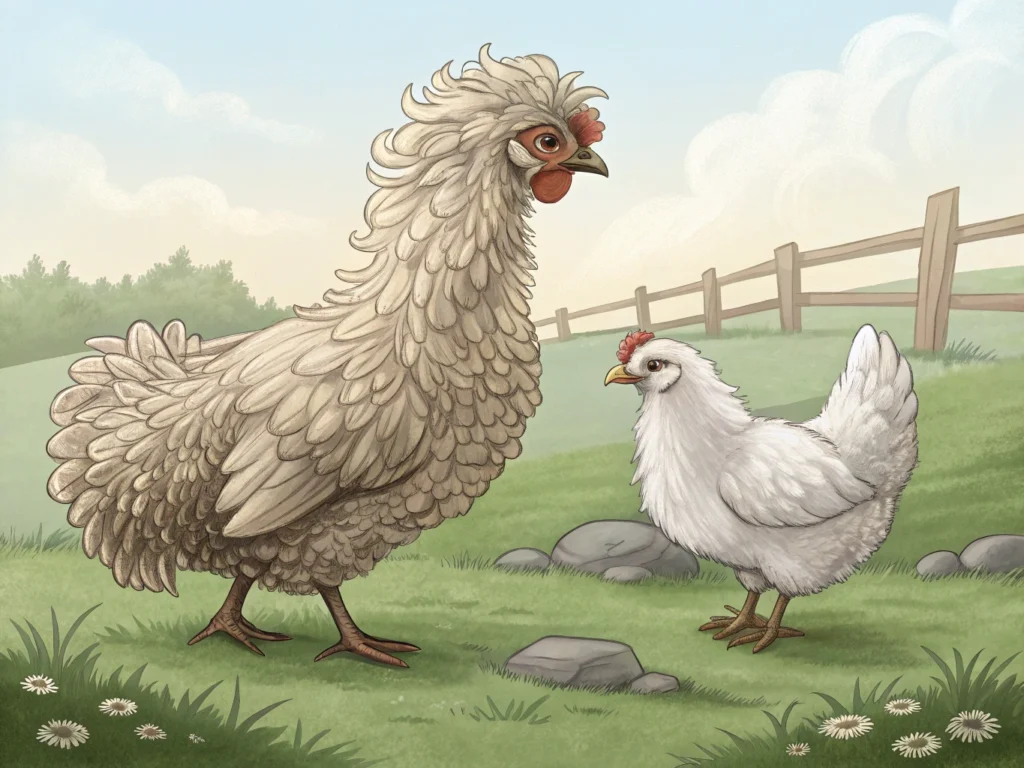
Breeding Frizzle Chickens: Best Practices and Considerations
My neighbor Rosa once made the mistake of breeding two Frizzle chickens without knowing the consequences. The chicks, while initially adorable, soon showed signs of feather breakage and weakness. That is when she called me over, holding a frazzle chick with eyes full of worry. I explained the genetic lottery she had unintentionally played.
When breeding Frizzle chickens, understanding genetics is crucial:
- How the Frizzle Gene Works: As mentioned, the frizzle trait is caused by a dominant gene. Breeding a frizzle with a smooth-feathered bird (non-frizzle) usually results in offspring with ideal frizzled plumage. However, two frizzle parents can produce frazzles, which suffer from overly fragile feathers, poor insulation, and susceptibility to weather and stress.
- Why Not to Breed Two Frizzles: Frazzles are often weak and require special care. Their feathers break easily, exposing them to cold and infections. Ethically, it is discouraged to intentionally produce such birds unless for specific educational or veterinary purposes.
- Responsible Breeding Strategies: The best practice is to pair a frizzled bird with a smooth-feathered partner. Keep careful records, avoid inbreeding, and prioritize the health of both the chicks and the breeding adults.
Breeding Frizzle chickens is an art backed by science. With attention to genetics and ethical practices, you can enjoy a thriving, feather-fantastic flock that brings joy without unintended suffering.
Egg Production and Broodiness in Frizzle Chickens
When I started keeping chickens, I did not expect to be collecting eggs from a bird that looked like it belonged on a fashion runway. Yet every morning, my Frizzle hens offer a charming surprise tucked away in their nest boxes. While they may look ornamental, Frizzle chickens are perfectly capable layers, especially when they come from productive parent breeds.
ANNONCE
- Egg Characteristics and Laying Frequency: On average, a Frizzle hen will lay about 120 to 150 eggs annually. The eggs are typically small to medium-sized and come in soft shades of white, cream, or light brown, depending on the breed base.
- Broodiness and Mothering Abilities: Frizzles are known to go broody occasionally. Their maternal instincts are solid, though their feather structure can sometimes make them less efficient at incubating eggs due to heat dispersion.
- Are Frizzle Chickens Good Layers? Absolutely—but with a caveat. Their laying capability is inherited from the breed they’re based on. A Frizzled Leghorn, for example, will lay more consistently than a Frizzled Cochin bantam.
Keep in mind that while Frizzles are delightful layers, they are not typically raised for commercial egg production. Their charm lies in the blend of function and flair.
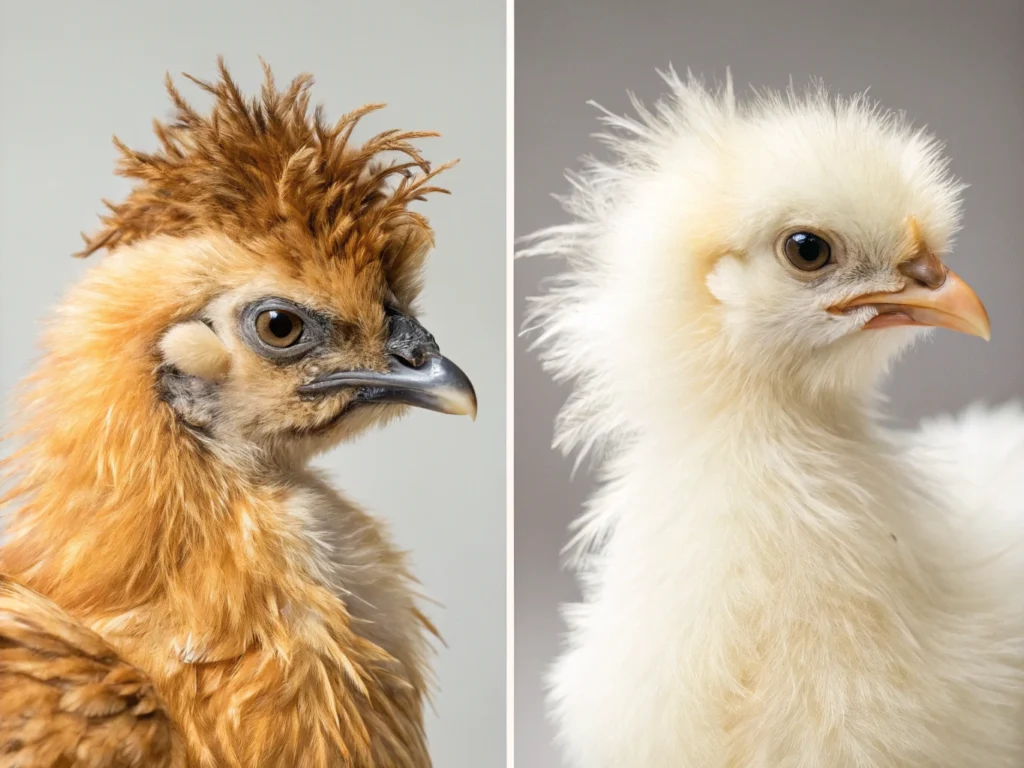
Frizzle Chickens vs. Silkies: Understanding the Differences
One day, a visitor pointed at my coop and said, “That Silkie sure looks different today!” I smiled and replied, “That’s not a Silkie—that curly queen is a Frizzle.”
- Is a Frizzle Chicken a Silkie? No, though the confusion is understandable. Both breeds share fluffy, unusual feathering, and gentle temperaments. However, a Frizzle is defined by its curled feathers, whereas Silkies have soft, fur-like plumage due to a lack of barbicels.
- Comparing Physical Traits and Feather Types: Frizzles often exhibit more dramatic curls and have standard chicken skin and feather coloring. Silkies, in contrast, have black skin, blue earlobes, and five toes.
- Suitability for Various Climates: Frizzles and Silkies both require extra protection from cold and wet conditions. However, Silkies generally tolerate cooler temperatures slightly better due to their denser plumage.
So, while you might spot similarities at a glance, the details reveal two distinctly fascinating breeds.
Caring for Frizzle Chickens: Health and Maintenance
Caring for Frizzle chickens requires a touch of extra TLC. Think of them as the divas of the chicken world—gorgeous, charming, but with specific needs to stay happy and healthy.
ANNONCE
- Housing and Shelter Requirements: Because of their less protective plumage, Frizzles need draft-free, well-insulated coops. Bedding should be dry and clean to prevent moisture-related illnesses.
- Diet and Nutrition: A balanced poultry feed rich in protein is essential, especially during molting. Supplement with greens, grains, and occasional treats like scrambled eggs or yogurt.
- Common Health Issues and Prevention: Due to their feather fragility, Frizzles are more susceptible to mites and lice. Regular dust baths, coop hygiene, and health checks are non-negotiable.
Treat your Frizzles with the care you would give any delicate treasure, and you will be rewarded with their beauty and affection.
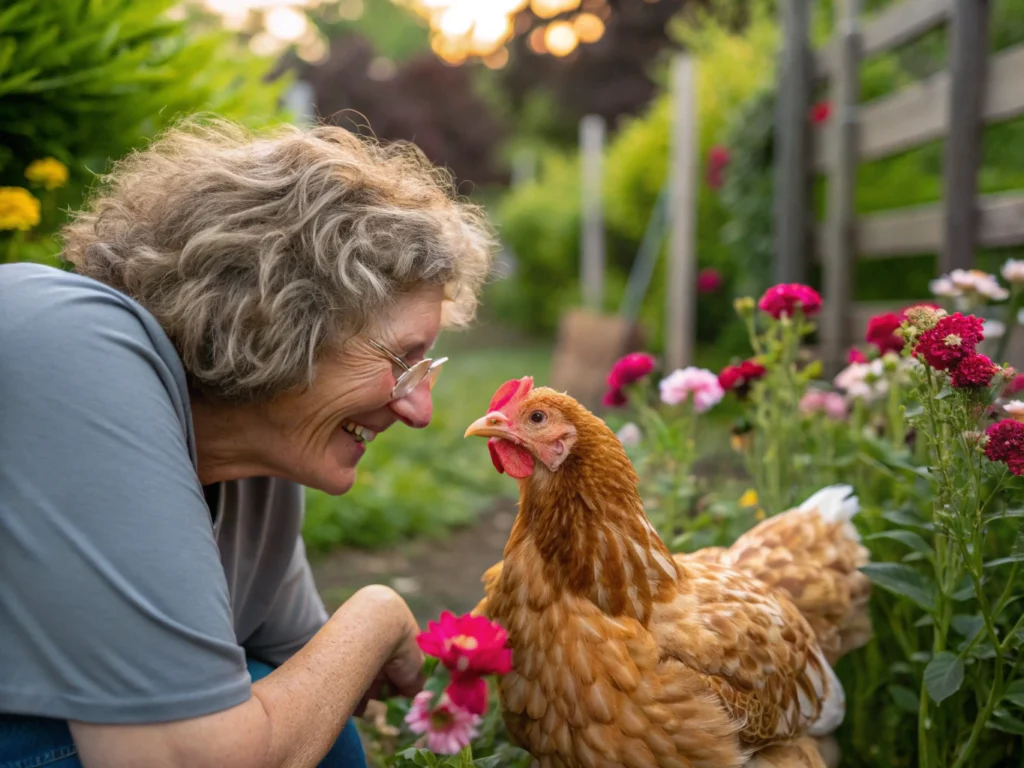
Frizzle Chickens in Exhibitions and as Pets
My youngest daughter insists on taking our Frizzle hen, Rosie, to every county fair. And every time, Rosie steals the show.
- Show Standards and Exhibition Tips: Frizzle chickens are judged primarily on feather quality, uniform curl, color, and overall health. Regular grooming, feather maintenance, and gentle handling are key.
- Frizzle Chickens as Family-Friendly Pets: These birds thrive in family settings. They are gentle with children, adapt well to small yards, and often develop friendly bonds with their keepers.
Their eye-catching appearance and lovable temperament make them one of the most rewarding poultry breeds to raise.
Frequently Asked Questions (FAQs) About Frizzle Chickens
- What Is a Frizzle Chicken? A Frizzle chicken is a bird with a genetic trait that causes its feathers to curl outward instead of lying flat. It is not a breed in itself but rather a feathering pattern that can appear in several chicken breeds.
- Why Can’t You Breed Two Frizzle Chickens? Breeding two Frizzles can result in “frazzle” chicks, which have overly fragile feathers, making them vulnerable to cold, injury, and stress.
- Are Frizzle Chickens Good Layers? Yes, especially when derived from productive breeds. However, they are not raised primarily for egg production.
- Is a Frizzle Chicken a Silkie? No. Although both have unique feather types and calm temperaments, they are genetically and visually different breeds.
Conclusion
Raising Frizzle chickens is like keeping a small troupe of feathered entertainers in your backyard. They bring beauty, gentleness, and a splash of whimsy to any flock. With proper care and ethical breeding, these birds offer both charm and companionship.
ANNONCE

